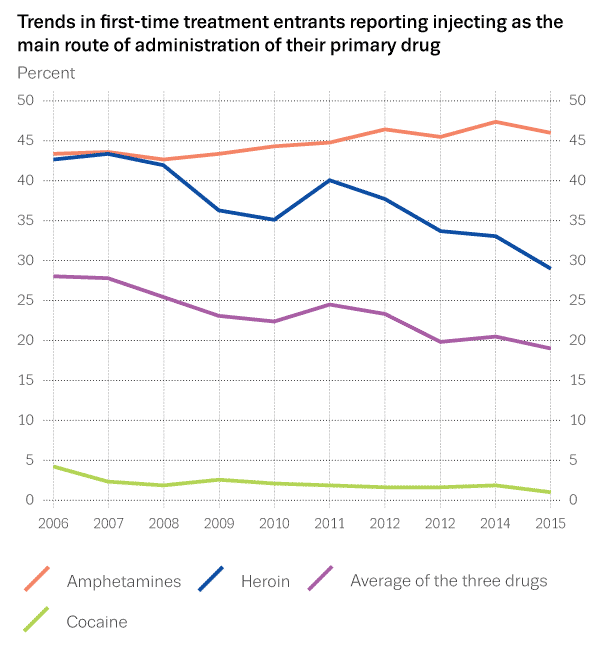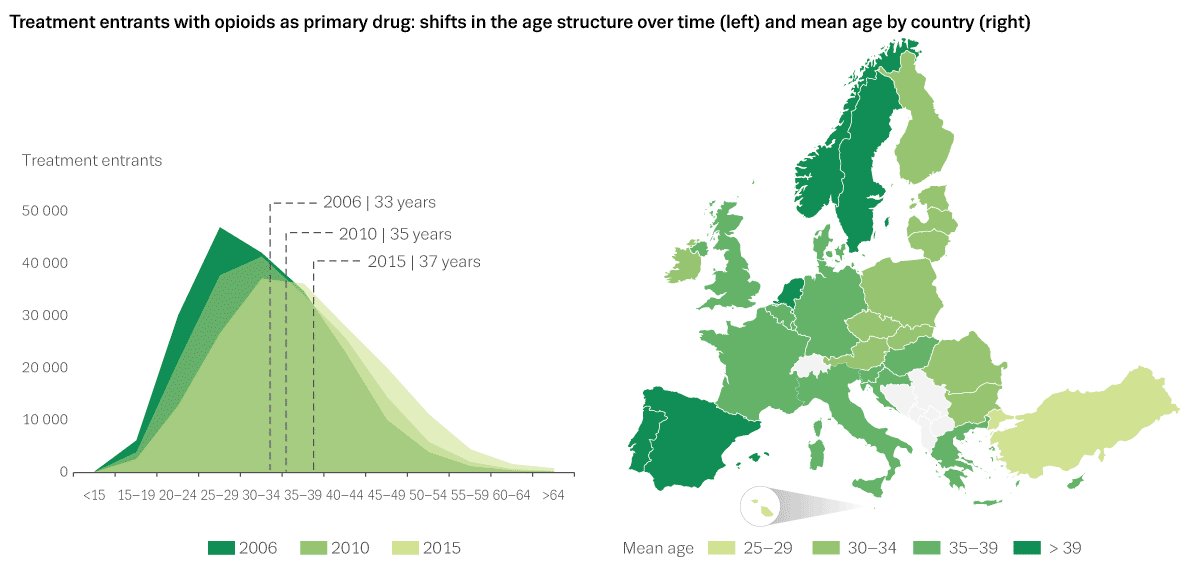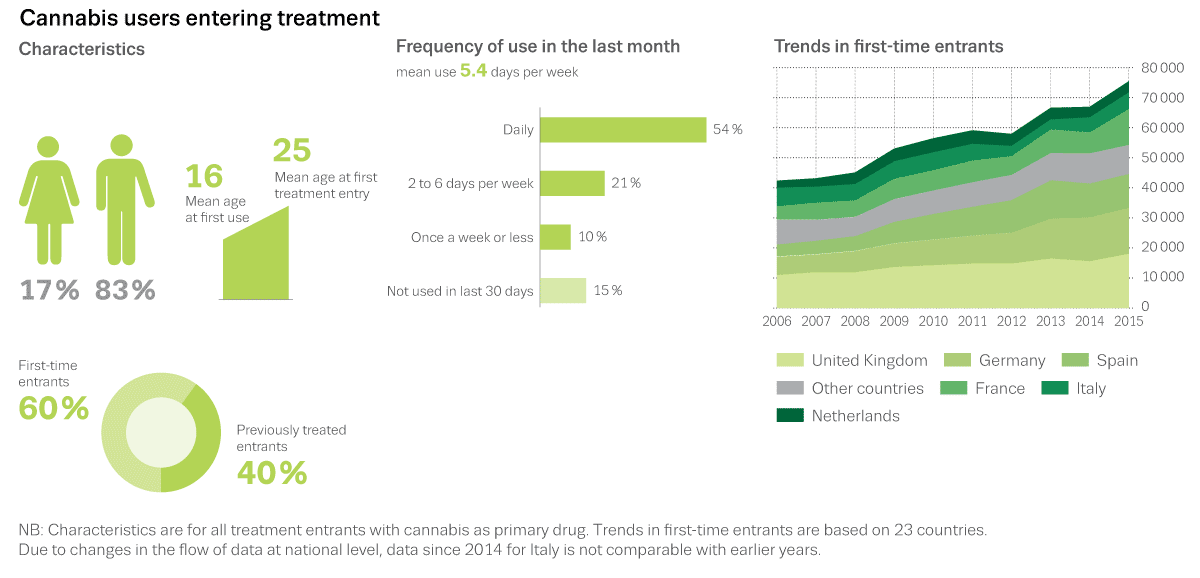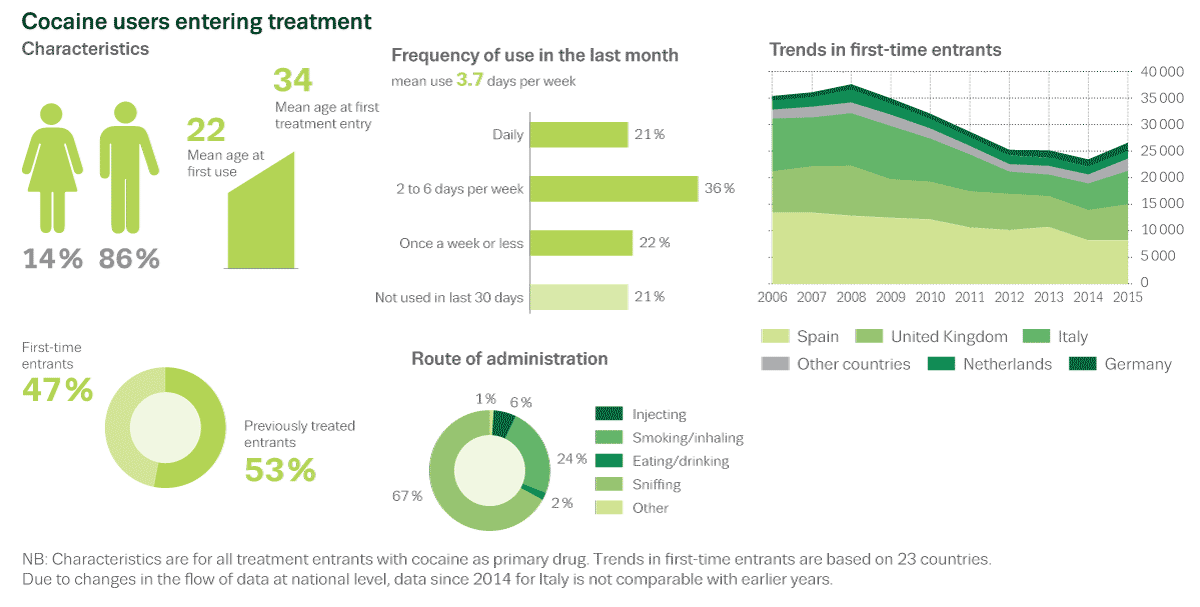Statistical Bulletin 2017 — treatment demand
Archived content
Information on the number of people entering treatment for a drug problem provides insight into general trends in problem drug use and also offers a perspective on the organisation and uptake of treatment facilities. ‘Treatment demand data’ come from each country with varying degrees of national coverage, principally from outpatient and inpatient centres’ treatment records.
Data tables
Use the menu below to find data sets of interest.
Graphics
Click on a graphic from the thumbnails below
Methods and definitions used
The EMCDDA Treatment Demand Indicator (TDI) focuses on the number and characteristics of entrants into treatment in the EU Member States, Norway and Turkey. The EMCDDA monitors data on primary/secondary drug, patterns of drug use, and socio-demographic information, primarily from entrants into specialised drug treatment centres. Meta data on factors likely to influence the interpretation, validity and reliability of the data is collected and all the information made available in the Data and statistics section (Statistical Bulletin) of the European Drug Report (EDR).
The EMCDDA encourages countries to harmonise their data collection and reporting (1). Nevertheless, differences in national monitoring systems, coverage and definitions exist and will influence the interpretation and comparability of the results. It is important to be aware of changes in the monitoring system and coverage within individual countries when interpreting trends.
Users of the data should carefully consider the methods and definitions described below and the notes associated with the data in the Statistical Bulletin. The underlying protocol and guidance to data providers offers further information necessary for interpreting the data. The individual country National reports are a source of contextual and methodological information and the basis of much of the information here. All of the above are available on the EMCDDA website (see ‘Key links’ below).
Data on entrants into treatment provide one perspective of the drug situation and should be considered within the broader range of information available. Cross-referencing between data-sets provides both additional insights and a check of validity. With data on the characteristics of almost half a million entrants into treatment across Europe, the TDI complements all of the key data-sets collected by the EMCDDA. In particular, information on patterns of drug use, such as primary drug and injecting behaviour, complement estimates of the prevalence of problem drug use (PDU), drug-related infectious diseases (DRID) and drug-related deaths (DRD). Information on the number of entrants into treatment in a given year also contributes to estimates of total treatment utilisation, i.e. the number in treatment, including those in long-term maintenance treatment, and acts as a counterpoint to estimates of prevalence in the general population (general population survey – GPS).
Purpose and aims
The primary purpose of the information collected by the TDI indicator is to gain insights into the characteristics, risk behaviours and drug use patterns of people with drug problems in the community, and to help to estimate trends in the number (prevalence and incidence) and patterns of high-risk drug use, ideally in combination with other drug indicators. TDI is an indirect indicator of the unobserved level of people that are potentially in need of drug treatment.
The objective of the TDI is to collect information in a harmonised and comparable way across all Member States on the number and profile of people (clients) entering drug treatment during each calendar year.
Definitions
A case is a client who starts a drug treatment episode at a treatment centre during the calendar year 1 January to 31 December for problems created by his/her drug use. Data is collected on individual clients rather than on episodes of treatment.
Drug treatment is defined as an activity (or activities) that directly targets people who have problems with their drug use and aims to achieve defined objectives with regard to the alleviation and/or elimination of these problems, provided by experienced or accredited professionals, in the framework of recognised medical, psychological or social assistance practice.
The primary drug is the drug that causes the client the most problems at the start of treatment. This is usually based on the request made by the clients and/or on the diagnosis made by a therapist, commonly using international standard instruments (e.g. ICD-10; DSM, ASI) or clinical assessment. This item is of central importance and it is, in principle, collected for every client.
Definitions and guidelines for each of the data items collected in the TDI are available in the TDI standard protocol 3.0 (see ‘Key links’ below).
Methods
Each EMCDDA Member State (28 EU Member States, Norway and Turkey) collects a standard set of items about each person entering drug treatment in the calendar year. These data are then aggregated at the national level and reported to the EMCDDA through the respective template of an online data collection system called Fonte (see below). The data reported from each country to the European level are thus a pre-defined set of outputs obtained from the TDI national treatment databases.
At the national level, data are collected according to an established European protocol: the TDI standard protocol 3.0. The protocol provides a uniform structure for reporting on the number and the characteristics of clients referred to drug treatment facilities and it is based on 24 items concerning treatment provision, the characteristics of clients and their patterns of drug use.
The protocol provides detailed guidance on methods of data collection and reporting (see ‘Key links’ below).
Limitations
The TDI has a long tradition, and has been adopted in all EU Member States, Norway and Turkey. Nevertheless, a number of aspects of TDI data collection should be considered when interpreting the data:
- The nature of each national reporting system.
- The proportion of all entrants covered by the TDI monitoring system within a country. The TDI system does not always cover all treatment providers in a country, resulting in possible under-reporting. Information on data coverage is monitored, though for some countries the proportion of the total number of treatment units and, more often, the proportion of the total number of clients within the TDI system is not known.
- Differences in individual questions. Definitions for individual question items are not always fully compatible with the EMCDDA TDI protocol, even though significant progress has been made since the establishment and implementation of the indicator.
- The existence and nature of double counting controls. A client may enter treatment more than once during the same year, either in the same facility or in another facility; if the national monitoring system does not have a system to avoid double counting (such as using a unique identifier) it is possible for a client to be counted twice.
- Significant changes of treatment systems and data coverage over time at the national level. These may bias the interpretation of trends within a country. This is often due to the improvement and extension of the treatment monitoring system to the whole treatment system in a country.
- Information on the national reporting system, coverage, definitions, and double counting controls have been compiled by country, to aid interpretation (see below). Specific information provided by the country that might influence interpretation has also been included. Cross-referencing with EMCDDA and other data collections is recommended.
Key links
For further information please refer to the following:
Other publications
(1) The EMCDDA publishes a detailed Protocol on how to collect the TDI, holds annual meetings of both experts and data providers, provides direct assistance to data providers and monitors and reviews the academic literature. Further information is available on the EMCDDA website.

















